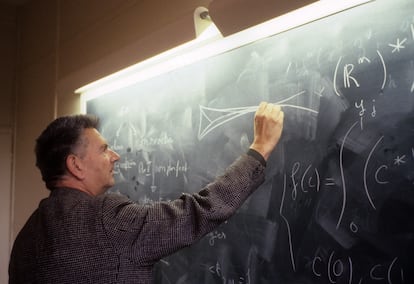René Thom, the mathematician who preferred meaning to rigor
Thom, winner of the Fields Medal for his groundbreaking work in geometry and creator of the influential catastrophe theory, was born in France 100 years ago

In May 1940, as Germany invaded France, 16-year-old René Thom was finishing high school in Montbeliard, his hometown. Six years later — having completed his degree at the prestigious École normale supérieure, where he had been rejected on his first attempt to enter — he was pursuing a PhD in mathematics at the University of Strasbourg, where he met various members of the Bourbaki group, at the time immersed in the task of rewriting modern mathematics. It was also there that he began his work in geometry, which would lead him to win the Fields Medal a decade later.
His work made it possible to effectively classify the different types of geometric shapes that exist. We can explain classification in mathematics by analogy, as Thom himself would have, with taxonomic classification in biology. Like every animal, every geometric shape belongs to a species, which are grouped into genera, which in turn are grouped into families. Higher up we have the order, the phylum, the class, and the kingdom. In biology, to accomplish this classification, certain traits are identified (such as hair or scales), which are then used to differentiate the animals of different groups. Something similar takes place in mathematics.
In 1854, Bernhard Riemann defined with certain rigor the concept of species in the context of geometry, which today is known as the Riemannian variety. Over the next 100 years, several mathematicians discovered certain geometric traits with which different species could be distinguished, like the Euler characteristic or the Betti numbers.
More geometric concepts, akin to genus or family, were introduced. However, just like today we are far from knowing every biological species or genera that exist on Earth, knowing all the geometric species or genera was not possible; there were just too many. Then, everything changed when, in the early 1950s, René Thom introduced a classification analogous to that of kingdom, much higher up the taxonomic hierarchy.
Thom established that two geometric shapes were in the same geometric kingdom if one could be transformed into the other through a certain type of process. For example, when a cell is subdivided, its membrane starts out shaped like a sphere; but after subdivision, it becomes two spheres. The geometric process by which the first sphere becomes the other two is called cobordism, and it keeps the objects within the same kingdom. The figure of the bull is also in the same kingdom as the figure of the sphere, although the geometric process is different.
Not content with that, Thom found and classified all possible geometric kingdoms. This feat, unprecedented in the history of geometry, gave rise to a revolution that continues today. Such was the impact, that the following three editions of the Fields Medal were won by geometers whose work was based on Thom’s new classification: John Milnor in 1962, Stephen Smale in 1966 and Sergei Novikov in 1970.
Shortly after receiving the Fields Medal, Thom obtained a permanent position at the French Institut des Hautes Études Scientifiques, where he created a new mathematical basis for biology or semiotics: the Catastrophe Theory. With it, he intended to address the processes in which continuity is broken, such as the development of an embryo.
In his memoir, Thom connects his radical change of research topic to his encounter with mathematician Alexander Grothendieck: “His technical superiority was crushing. His seminar attracted the whole of Parisian mathematics, whereas I had nothing to offer. That made me leave the strictly mathematical world and tackle more general notions, like the theory of morphogenesis, a subject which interested me more and more and led me towards a very general form of ‘philosophical’ biology.”
His philosophical perspective, a continuation of Heraclitus and Aristotle, saw the obsession with accuracy as an obstacle to understanding. “If one must choose between rigor and meaning, I shall unhesitatingly choose the latter,” he stated. He preferred qualitative explanations to quantitative ones, and was very critical of modern mathematics (promoted, especially, by his former Bourbaki colleagues), which, from his point of view, only recognized algebra as a source of rigor, while Thom preferred geometry.
Paradoxically, Thom’s greatest contribution — his classification of geometric shapes — helped reduce geometry to algebra, as French mathematician and Bourbaki co-founder Jean Dieudonné wryly observed in 1972 in an open letter to Thom: “It’s ironic that Thom, who clearly has an aversion to algebra, will be remembered for his original way of using it in his theory of cobordism.”
Sign up for our weekly newsletter to get more English-language news coverage from EL PAÍS USA Edition
Tu suscripción se está usando en otro dispositivo
¿Quieres añadir otro usuario a tu suscripción?
Si continúas leyendo en este dispositivo, no se podrá leer en el otro.
FlechaTu suscripción se está usando en otro dispositivo y solo puedes acceder a EL PAÍS desde un dispositivo a la vez.
Si quieres compartir tu cuenta, cambia tu suscripción a la modalidad Premium, así podrás añadir otro usuario. Cada uno accederá con su propia cuenta de email, lo que os permitirá personalizar vuestra experiencia en EL PAÍS.
¿Tienes una suscripción de empresa? Accede aquí para contratar más cuentas.
En el caso de no saber quién está usando tu cuenta, te recomendamos cambiar tu contraseña aquí.
Si decides continuar compartiendo tu cuenta, este mensaje se mostrará en tu dispositivo y en el de la otra persona que está usando tu cuenta de forma indefinida, afectando a tu experiencia de lectura. Puedes consultar aquí los términos y condiciones de la suscripción digital.










































